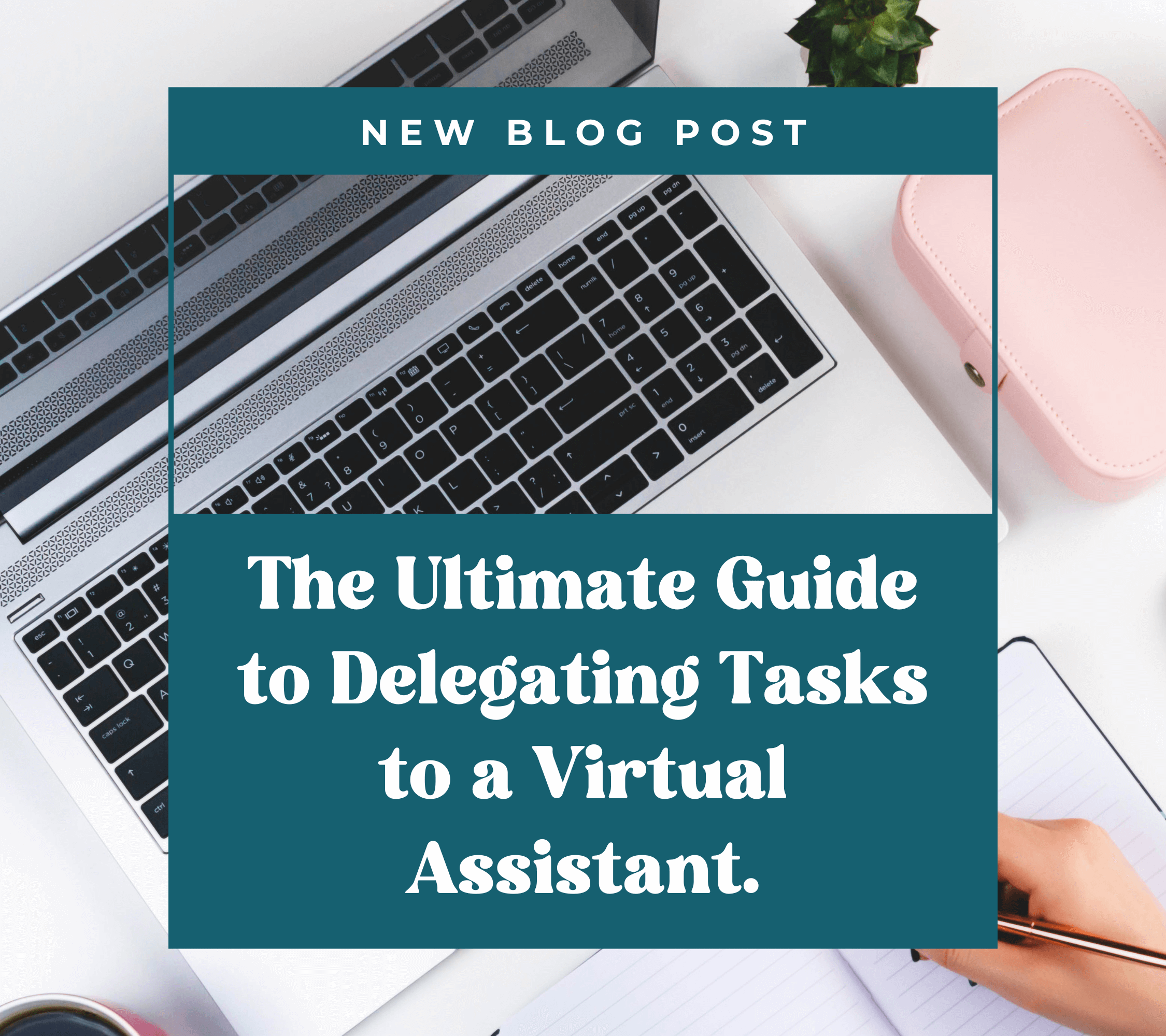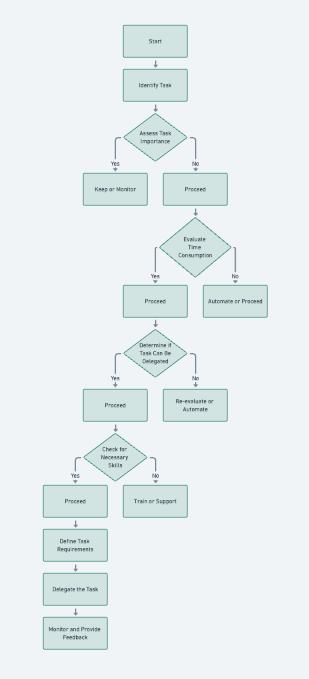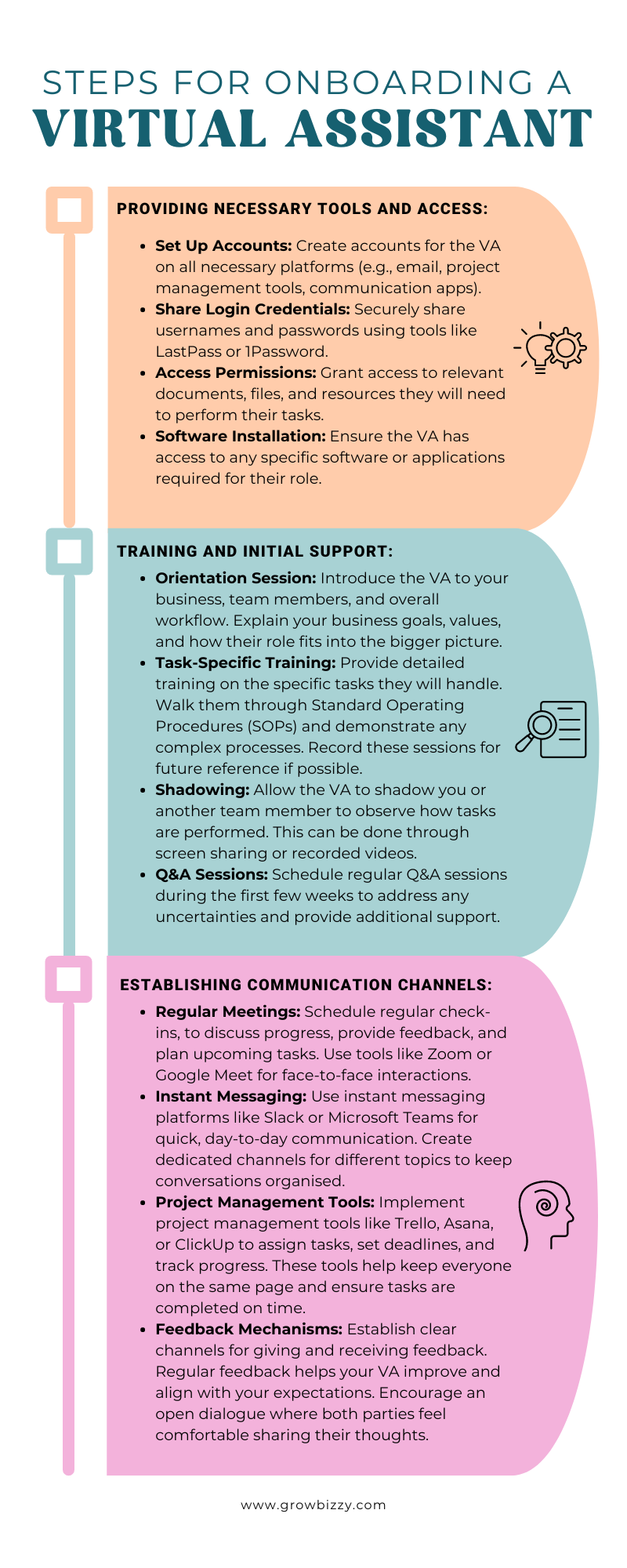
The Ultimate Guide to Delegating Tasks to a Virtual Assistant
“Do what you do best and outsource the rest.” - Peter Drucker
Feeling overwhelmed by the endless list of tasks that demand your attention every day? Imagine having a trusted partner to take on those routine tasks, giving you the freedom to focus on strategic growth and innovation. In this ultimate guide, we’ll walk you through the essential steps to effectively delegate tasks to a virtual assistant (VA), so you can reclaim your time and boost your productivity.
Introduction
As a small business owner, your time is one of your most valuable assets. Delegating tasks to a virtual assistant not only helps you manage your workload more efficiently but also allows you to focus on strategic initiatives that drive growth. By effectively leveraging a VA, you can achieve a better work-life balance and enhance your business's overall productivity.

With that said, here are the essential steps to effectively delegate tasks to a virtual assistant and boost your productivity today! 👊
Identifying Tasks to Delegate
To start, identify which tasks are taking up most of your time and could be handled by someone else. Effective delegation begins with understanding what tasks are best suited for a virtual assistant. Here's a closer look at common tasks you can delegate:
Administrative Tasks: These routine tasks often consume a significant portion of your day but are essential for smooth operations. A VA can manage your emails, schedule appointments, handle data entry, and organise your digital files. By delegating these tasks, you can ensure that nothing falls through the cracks while freeing up your time for more strategic activities.
Customer Service: Providing excellent customer service is crucial, but it can be time-consuming. A VA can respond to customer inquiries, manage support tickets, and provide follow-up services. They can also handle live chat support and monitor social media for customer feedback, ensuring your customers always receive timely and professional responses.
Social Media Management: Maintaining a strong social media presence is essential for brand awareness and engagement, but it requires consistent effort. A VA can create and schedule posts, engage with followers, and monitor social media analytics. They can also assist with developing content calendars and brainstorming new ideas to keep your audience engaged.
Content Creation: Producing high-quality content is vital for your marketing strategy, but it can be challenging to keep up with the demand. A VA with content creation skills can write blog posts, design graphics, edit videos, and create other marketing materials. This allows you to maintain a steady stream of content without sacrificing quality.
Technical Support: Technical issues can disrupt your workflow and frustrate your team. A VA with technical expertise can help maintain your website, troubleshoot software issues, and provide IT support. They can also assist with setting up new systems and integrating automation tools to streamline your operations.
By carefully selecting tasks to delegate, you can maximise the efficiency and effectiveness of your virtual assistant. Start by listing all your daily, weekly, and monthly tasks, then identify which ones can be handed off. Consider tasks that are repetitive, time-consuming, or outside your core expertise. Delegating these tasks allows you to focus on high-impact activities that drive business growth.

Finding the Right Virtual Assistant
Finding the right VA can make a significant difference in how effectively tasks are delegated. Here’s a detailed look at the steps you should take, focusing on local networks in Australia and New Zealand:
Where to Look for VAs
There are several platforms and methods you can use to find a qualified virtual assistant locally:
VA Agencies: Virtual assistant agencies in Australia and New Zealand specialise in providing trained VAs for different business needs. Agencies such as VA Directory (Australia) and New Zealand Virtual Assistant Directory (New Zealand) can match you with a VA based on your specific requirements, ensuring a higher level of reliability and professionalism.
Professional Networks: Leverage your professional network to find VAs through referrals. Ask for recommendations from fellow business owners, industry forums, or LinkedIn connections. Local business groups and chambers of commerce in Australia and New Zealand can also be valuable resources for finding trusted VAs.
Job Boards and Classifieds: Websites like Seek (Australia and New Zealand) and Trade Me Jobs (New Zealand) offer job posting services where you can advertise for a VA. These platforms have a wide reach and can help you find local talent.
Qualities to Look for in a VA
Selecting the right VA involves evaluating their skills and personal attributes. Look for the following qualities:
Strong Communication Skills: Effective communication is crucial for remote work. Ensure the VA can clearly articulate their thoughts, ask pertinent questions, and provide regular updates.
Reliability: A reliable VA consistently meets deadlines, follows through on tasks, and maintains a high level of professionalism. Look for a proven track record of dependability.
Relevant Experience: Depending on your needs, find a VA with experience in specific areas like administrative support, customer service, social media management, or technical tasks. Review their portfolio and previous work experience.
Proactive Attitude: A proactive VA anticipates needs, identifies potential issues before they arise, and offers solutions. They take initiative and don't wait for instructions for every small task.
Adaptability: Your business needs might change over time. An adaptable VA can handle new tasks, learn new tools, and adjust to shifting priorities without much hassle.
Assessing Fit for Collaboration
Instead of a traditional interview, focus on assessing whether working together will be a good fit. Here are some best practices:
Prepare Relevant Questions: Discuss their experience, specific skills, and work style. For example:
"Can you describe your previous experience with managing social media accounts?"
"How do you prioritise tasks when managing multiple projects?"
"What tools and software are you proficient in?"
Evaluate Communication Skills: Pay attention to how they communicate during your discussions. Clear, concise, and prompt responses are good indicators of strong communication skills.
Discuss Availability and Flexibility: Ensure their availability aligns with your business needs. Ask about their working hours, time zone differences, and flexibility to handle urgent tasks.
Provide a Small Test Task: Give them a test task relevant to the work they will be doing. This helps you assess their skills, attention to detail, and ability to follow instructions.
Check References: Ask for and follow up on references from previous clients or employers. This can provide insights into their work ethic, reliability, and performance.
Assess Cultural Fit: Ensure the VA’s work style and values align with your business culture. This is especially important if they will be working closely with your team.
By focusing on local networks and carefully considering where to look, what qualities to prioritise, and how to assess fit for collaboration, you can find a VA in Australia or New Zealand who not only meets your business needs but also enhances your productivity and contributes to your long-term success.
Preparing for Delegation
Preparation is key to successful delegation. By taking the time to organise and plan, you set the stage for a smooth and productive working relationship with your virtual assistant. Here are the crucial steps to take:
Create a List of Tasks and Responsibilities
Start by making a comprehensive list of all the tasks you perform regularly. Break down your tasks into daily, weekly, and monthly activities. Identify which tasks are repetitive, time-consuming, or outside your core expertise. This list will help you determine which tasks can be handed off to a VA.
Prioritise Tasks: Rank tasks based on their importance and the amount of time they take. Focus on delegating lower-priority tasks first to free up time for strategic activities.
Be Specific: Clearly define each task's requirements, including the tools and resources needed to complete them. Specificity helps avoid misunderstandings and ensures your VA knows exactly what to do.
Set Clear Expectations and Goals
Effective delegation requires clear communication of your objectives and desired outcomes. Setting expectations helps your VA understand what success looks like and how their work contributes to your business goals.
Define Success: Outline what a successful completion of each task looks like. Include details such as deadlines, quality standards, and any specific guidelines or preferences.
Communicate Regularly: Establish regular check-ins and progress updates. This helps ensure that tasks are on track and provides an opportunity to address any issues or questions.
Provide Context: Explain how each task fits into the larger picture of your business. Understanding the context can motivate your VA and give them a sense of purpose.
Develop Standard Operating Procedures (SOPs)
Creating SOPs is essential for maintaining consistency and quality in the tasks you delegate. SOPs provide step-by-step instructions that your VA can follow, ensuring tasks are completed correctly and efficiently.
Document Processes: Write detailed, easy-to-follow instructions for each task. Include screenshots, videos, or other visual aids if necessary. The more detailed your SOPs, the less room there is for error.
Include Best Practices: Share tips and best practices that you’ve learned from performing the tasks yourself. This can help your VA work more effectively and avoid common pitfalls.
Update Regularly: Review and update your SOPs periodically to reflect any changes in your processes or tools. Keeping your SOPs current ensures your VA always has the most accurate information.
Preparing for delegation involves creating a detailed list of tasks, setting clear expectations and goals, and developing comprehensive SOPs. By investing time in these preparatory steps, you set the foundation for a successful and productive relationship with your virtual assistant. Start delegating today, and watch your business thrive as you focus on what truly matters—growth and innovation.
Onboarding Your Virtual Assistant
A smooth onboarding process sets the stage for a successful working relationship. By investing time in onboarding, you ensure your VA is well-prepared and equipped to contribute effectively. Here are the essential steps to consider:

Provide Necessary Tools and Access
To enable your VA to perform their tasks efficiently, ensure they have access to the necessary tools and systems. This involves setting up accounts and permissions for the software and platforms they will use.
Software and Tools: Provide access to any software, applications, or online tools required for their tasks. This may include project management tools (e.g., Trello, Asana), communication platforms (e.g., Slack, Zoom), and any industry-specific software.
Login Credentials: Set up login credentials for systems and platforms they need to access. Ensure all passwords and usernames are shared securely, using tools like LastPass or 1Password.
Documentation: Share any relevant documents, templates, and resources they will need. This includes your SOPs, brand guidelines, and any other reference materials.
Training and Initial Support
Offering guidance and training during the initial phase helps your VA get up to speed quickly and understand your expectations. This period is crucial for building a solid foundation for future collaboration.
Orientation Session: Schedule an orientation session to introduce your VA to your business, team members, and overall workflow. Explain your business goals, values, and how their role fits into the bigger picture.
Task-Specific Training: Provide detailed training on the specific tasks they will be handling. Walk them through the SOPs and demonstrate any complex processes. If possible, record these sessions for future reference.
Shadowing: Allow your VA to shadow you or another team member to observe how tasks are performed. This can be done through screen sharing or recorded videos.
Q&A Sessions: Encourage your VA to ask questions and seek clarifications. Schedule regular Q&A sessions during the first few weeks to address any uncertainties and provide additional support.
Establish Communication Channels
Effective communication is critical for remote work. Setting up reliable communication channels ensures that you and your VA can stay connected, share updates, and address any issues promptly.
Regular Meetings: Schedule regular check-ins, such as weekly or bi-weekly meetings, to discuss progress, provide feedback, and plan upcoming tasks. Use tools like Zoom or Google Meet for face-to-face interactions.
Instant Messaging: Use instant messaging platforms like Slack or Microsoft Teams for quick, day-to-day communication. Create dedicated channels for different projects or topics to keep conversations organised.
Project Management Tools: Implement project management tools like Trello, Asana, or ClickUp to assign tasks, set deadlines, and track progress. These tools help keep everyone on the same page and ensure tasks are completed on time.
Feedback Mechanisms: Establish clear channels for giving and receiving feedback. Regular feedback helps your VA improve and align with your expectations. Encourage an open dialogue where both parties feel comfortable sharing their thoughts.
A thorough onboarding process ensures your virtual assistant is well-prepared and confident in their role. By providing the necessary tools and access, offering comprehensive training and support, and establishing effective communication channels, you set the stage for a productive and successful working relationship. Start onboarding your VA today and watch your business operations become more efficient and streamlined.
Monitoring and Evaluating Performance
Monitoring your VA’s performance ensures tasks are completed to your satisfaction and helps maintain a high standard of work. By setting clear performance metrics, providing constructive feedback, and being flexible with task assignments, you can foster a productive and positive working relationship. Here’s how to focus on these areas effectively:
Setting Performance Metrics
Defining key performance indicators (KPIs) is essential for measuring your VA’s success and ensuring they meet your expectations. Clear performance metrics provide a benchmark for evaluating their work and identifying areas for improvement.
Identify Key Tasks: Start by identifying the most critical tasks your VA is responsible for. This could include administrative duties, customer service responses, social media engagement, or content creation.
Set Specific Goals: Establish specific, measurable goals for each task. For example, if your VA handles social media, a goal might be to increase follower engagement by 20% over the next three months.
Track Progress: Use tools like spreadsheets, project management software, or performance tracking apps to monitor progress against these goals. Regularly review these metrics to assess performance.
Adjust as Needed: Be open to adjusting KPIs as your business needs evolve or as you better understand your VA’s capabilities.
Providing Constructive Feedback
Regular, constructive feedback is crucial for helping your VA improve and stay on track. Effective feedback is specific, actionable, and balanced with both positive reinforcement and areas for improvement.
Be Specific: Provide detailed examples of what your VA is doing well and where there is room for improvement. Instead of saying, “Great job on the report,” say, “I appreciated the thorough research and clear presentation in the report.”
Focus on Actions: Frame feedback around specific actions and outcomes rather than personal attributes. This helps keep the feedback objective and focused on work performance.
Use the Sandwich Method: When giving constructive criticism, use the sandwich method—start with positive feedback, follow with areas for improvement, and end with another positive note. This helps maintain a positive tone and motivates your VA to improve.
Schedule Regular Feedback Sessions: Set up regular feedback sessions to discuss performance, address any concerns, and plan for future improvements. This can be part of your regular check-ins or separate dedicated meetings.
Adjusting Tasks and Responsibilities as Needed
Flexibility in task assignments is key to making the most of your VA’s strengths and adapting to changing business needs. Being open to adjusting tasks ensures your VA remains engaged and productive.
Assess Workload: Regularly review your VA’s workload to ensure they are not overwhelmed or under-utilised. Adjust tasks as necessary to maintain a balanced and manageable workload.
Leverage Strengths: Identify your VA’s strengths and assign tasks that align with their skills and interests. For example, if your VA excels in graphic design, consider assigning more design-related tasks.
Reassign Tasks: Be prepared to reassign tasks that are not being handled effectively. If your VA struggles with a particular task, consider training them further or delegating it to another team member who is better suited for it.
Encourage Skill Development: Support your VA’s professional growth by encouraging them to develop new skills and take on new challenges. This not only benefits your business but also keeps your VA motivated and engaged.
Monitoring and evaluating your virtual assistant's performance is essential for maintaining high standards and ensuring that tasks are completed efficiently. By setting clear performance metrics, providing constructive feedback, and being flexible with task assignments, you can create a productive and supportive working environment. Start implementing these strategies today to enhance your collaboration with your VA and drive your business forward.

Building a Long-Term Working Relationship
A strong working relationship with your virtual assistant (VA) can lead to long-term success for both your business and your VA. Fostering trust, recognising good performance, and encouraging professional development are key elements in building this relationship. Here’s how to focus on these areas effectively:
Fostering Trust and Reliability
Trust is the foundation of any successful working relationship. To build trust with your VA, ensure transparency, dependability, and mutual respect.
Be Transparent: Share your business goals, challenges, and successes with your VA. Being open about your expectations and how their work fits into the bigger picture helps build trust.
Consistent Communication: Maintain regular and open communication. Keep your VA informed about any changes in priorities, tasks, or company policies. This transparency fosters a sense of reliability and trustworthiness.
Dependability: Demonstrate reliability by following through on your commitments. If you promise to provide feedback or resources by a certain date, make sure you deliver. Your VA should do the same.
Mutual Respect: Treat your VA with respect and professionalism. Value their time, opinions, and contributions. Respect is a two-way street and essential for a trusting relationship.
Recognising and Rewarding Good Performance
Acknowledging and rewarding your VA’s hard work and contributions can boost morale and motivation. Recognition can come in various forms and doesn't always have to be monetary.
Verbal Recognition: Regularly acknowledge your VA’s efforts and successes. A simple “Great job on that project!” can go a long way in making them feel appreciated.
Written Praise: Highlight your VA’s accomplishments in team meetings, newsletters, or emails. Public recognition can boost their morale and encourage others.
Incentives and Bonuses: Consider providing incentives or bonuses for exceptional work. This could be in the form of monetary bonuses, gift cards, or additional time off.
Professional Development Opportunities: Offer opportunities for further training or courses that align with their career goals. This not only benefits them but also enhances their contributions to your business.
Celebrating Milestones: Celebrate work anniversaries, project completions, and other significant milestones. This can be through small tokens of appreciation or special acknowledgments.
Ensuring Ongoing Professional Development
Encouraging your VA to learn new skills and grow professionally benefits both your business and their career development. Continuous learning keeps them engaged and motivated.
Training Programs: Invest in training programs that help your VA develop new skills relevant to their role. This could include online courses, webinars, or workshops.
Skill Enhancement: Encourage your VA to pursue certifications or advanced training in areas that interest them and benefit your business. Provide financial support or time off for these pursuits.
Career Growth Discussions: Have regular discussions about their career goals and how they can align with your business objectives. Create a development plan that includes opportunities for growth within your company.
Mentorship: Offer mentorship opportunities within your organisation. Pair your VA with experienced team members who can provide guidance and support.
Learning Resources: Provide access to learning resources such as books, online courses, or subscriptions to industry publications. Encourage them to stay updated with the latest trends and best practices.
Building a long-term working relationship with your virtual assistant involves fostering trust and reliability, recognising and rewarding good performance, and ensuring ongoing professional development. By investing in these areas, you create a supportive and motivating environment that benefits both your VA and your business. Start building this relationship today, and watch your VA thrive and contribute to your long-term success.
Conclusion
Delegating tasks to a virtual assistant can transform your business by freeing up your time and increasing productivity. By following these steps, you can ensure a smooth delegation process and build a successful, long-term working relationship with your VA. Start delegating today, and watch your business thrive!
If you need a worksheet to clarify what tasks you should delegate get this worksheet delivered to your inbox.
When your ready to delegate and increase your productivity? Start today and experience the benefits of having a trusted virtual assistant by your side. Need help or have questions? Reach out to us, and let’s make delegation work for you!
